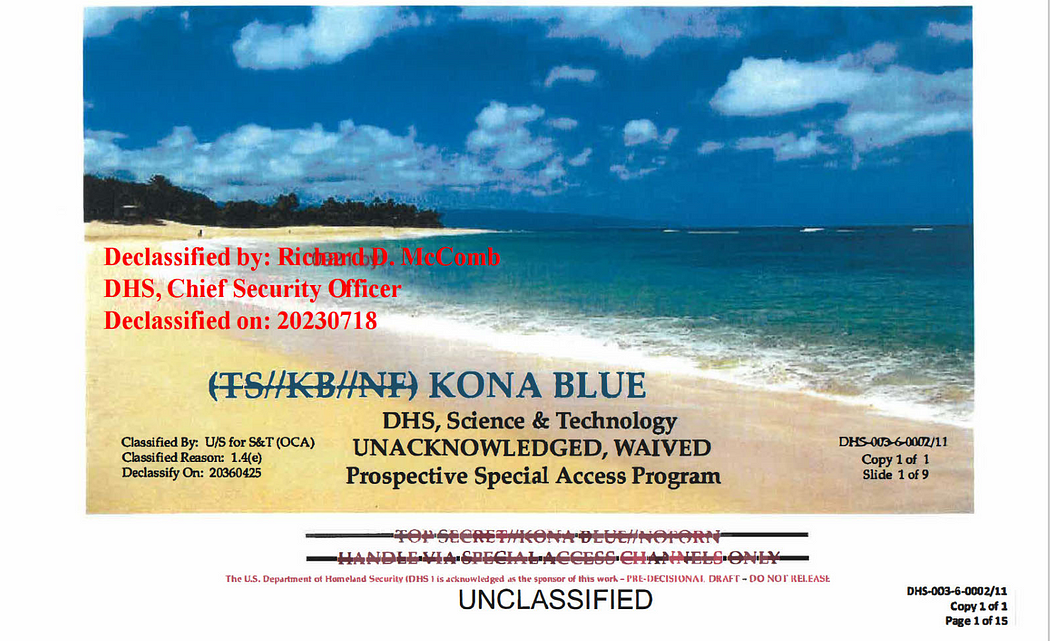Watch the full analysis with UFO Researcher Cristina Gomez, UFO Researcher Richard Dolan, The Debrief Editor and Chief Micah Hanks, and Fade to Black Radio host Jimmy Church.
Watch the KONA BLUE Analysis here -
In a significant development for UFO enthusiasts and researchers, the Department of Homeland Security (DHS) has officially released a trove of 56 pages of documents related to a secretive government program known as “Kona Blue.” The documents, which were declassified and approved for public release, shed light on a little-known initiative that sought to investigate and potentially reverse engineer advanced aerospace vehicles (AAVs) of possible non-human origin.
Kona Blue, it turns out, was proposed as an extension of the Advanced Aerospace Threat Identification Program (AATIP), which was run by the Defense Intelligence Agency (DIA) from 2009 to 2012. AATIP gained notoriety in 2017 when former program director Luis Elizondo came forward to reveal its existence and purpose in investigating UFOs, or as the government prefers to call them, unidentified aerial phenomena (UAP).

The newly released documents indicate that Kona Blue aimed to take the work of AATIP a step further by delving into the study of recovered AAVs. The program proposal outlined plans for data collection, consciousness and remote viewing research, and even medical studies related to these mysterious craft. Interestingly, Bigelow Aerospace Advanced Space Studies, a subsidiary of Robert Bigelow’s aerospace company, was involved in managing the earlier DIA AATIP program, and it appears they were also set to play a role in Kona Blue.
According to Micah Hanks, despite being briefly approved as a DHS special access program (SAP) in 2011, Kona Blue was abruptly cancelled after just six months, before it could receive any materials or funding. The reasons for its termination remain unclear, but some speculate that it may have been due to concerns about the justification for the program or issues with personnel and budget requirements.
UFO researchers and experts have weighed in on the significance of the Kona Blue documents. Richard Dolan, a prominent UFO historian, suggests that while Kona Blue may not be the “smoking gun” some had hoped for, it does raise questions about the extent of the government’s ongoing UFO research programs. He and others believe that related SAPs likely exist within various government agencies, studying AAVs and UFOs, even if Kona Blue itself did not move forward.

One notable aspect of the Kona Blue proposal is its emphasis on the potential threats these advanced technologies could pose to U.S. national security interests. This framing may have been an attempt to justify the need for SAP status and secure funding, as such programs are often shrouded in secrecy and operate with little oversight.
As the public and media continue to pore over the Kona Blue documents, many questions remain unanswered. Was this a genuine effort to investigate and understand UFOs, or simply an attempt to secure funding for theoretical studies? How many other similar programs exist within the labyrinthine world of government black budget projects? And perhaps most importantly, what do these programs know about the true nature and origin of UFOs?

The revelation of Kona Blue serves as a reminder that despite decades of official denials and stigma surrounding the topic of UFOs, the government has indeed been paying attention and investing resources into understanding this perplexing phenomenon. As more information comes to light, it becomes increasingly apparent that the question is not whether UFOs exist, but rather, what they are and what their presence means for humanity.
KONA BLUE with Richard Dolan and Micah Hanks
Access all of Cristina Gomez’ links — click here

Comments & Upvotes